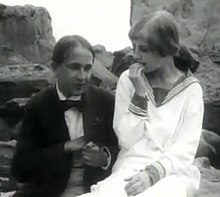Lev Vladimirovich Kuleschow
Lew Wladimirowitsch Kuleschow ( Russian Лев Владимирович Кулешов ; * January 1 July / January 13, 1899 greg. In Tambov ; † March 29, 1970 in Moscow ) was a Soviet director .
life and work
Kuleschow began as a painter in 1916 in Alexander Chanschonkow's film studios , where he worked as a set designer and assistant, among other things, for Yevgeny Bauer's films . From 1917 Kuleschow directed it himself. During the revolutionary years he made newsreels on the front lines of the civil war . In 1919 he took over the management of a training department at the State Film School in Moscow, where Vsevolod Pudowkin and, for a short time, Sergei Eisenstein studied.
He was the first to carry out film experiments on montage , which in 1922 he called the "Kuleschow effect". He replaced only one of a sequence of four short scenes and was able to show that the perception and meaning of the entire sequence changed. In 1928 he put forward the thesis that it was not so important how the shots were recorded, but how they were edited. The original assembly experiments are lost .
There were two basic assumptions that led him to his experiments:
- The actor is not an actor, but a film model that functions as a purely technical work by training motor skills and emotions .
- The essence of the film lies in the concatenation of the filmed fragments, not within the individual fragments.
Kuleschow combined z. B. three different shots (a bowl of soup, a coffin with the corpse of a little girl, a scantily clad woman on a divan) with the face of the actor Ivan Mosschuchin . These combined shots let the audience see completely different expressions on the actor's face - even though it was always the same shot. This is also known as the Kuleschow effect . The audience was impressed by Moshuchin's ability to express emotions such as hunger, sadness, and affection.
Alfred Hitchcock repeated this experiment in the film Das Fenster zum Hof . He combined the same shot of James Stewart looking at a half-naked woman and looking at a small dead dog.
Filmography
- 1918: The project of the engineer Pright (project inschenera Praita)
- 1918: Pesn ljubwi nedopetaja
- 1919: Smeltschak
- 1920: On the Red Front (Na krasnom fronte)
- 1922: Kawkasskije mineralnje vody
- 1924: The strange adventures of Mr. West in the land of the Bolsheviks (Neobychainie prikljutschenija mistera Westa w strane Bolshevikov)
- 1925: The death ray ( Lutsch Smerti )
- 1926: According to the law (Po sakonu)
- 1927: Wascha Snakomaja
- 1929: Dwa-Buldi-Dwa
- 1929: Wesjolaja Kanareika
- 1930: The Breakthrough (Proryw)
- 1931: Forty Hearts (Sorok serdez)
- 1932: Horizont (Gorizont)
- 1933: Weliki uteschitel
- 1940: Sibirjaki
- 1941: Slutschai wulkane
- 1942: Junyje partisany
- 1942: The Oath of Timur (Kljatwa Timura)
- 1943: My s Urala
- 1943: Bojewoi kinosbornik 13
Web links
- Lew Kuleschow in the Internet Movie Database (English)
- The Kuleschow effect to make yourself
- Biography on film-zeit.de
Individual evidence
- ↑ James Monaco. Understand film. Reinbek near Hamburg 2002, p. 429
- ↑ Viktor Šklovskij , Ejzenštejn. Rowohlt, Hamburg 1977, p. 129
- ↑ Izvolov, Nikolai; Drubek-Meyer, Natascha (2010). "Annotations for the Hyperkino Edition of Lev Kuleshov's Engineer Prite's Project (1918), Academia Series, RUSCICO, 2010". Studies in Russian and Soviet Cinema . 4 (1): 65-93.
- ^ Hyperkino edition (DVD): The project of the engineer Pright (1918). absolutMedien, 2008, accessed on November 17, 2016 .
| personal data | |
|---|---|
| SURNAME | Kuleshov, Lev Vladimirovich |
| ALTERNATIVE NAMES | Кулешов, Лев Владимирович (Russian) |
| BRIEF DESCRIPTION | soviet director |
| DATE OF BIRTH | January 13, 1899 |
| PLACE OF BIRTH | Tambov |
| DATE OF DEATH | March 29, 1970 |
| Place of death | Moscow |
